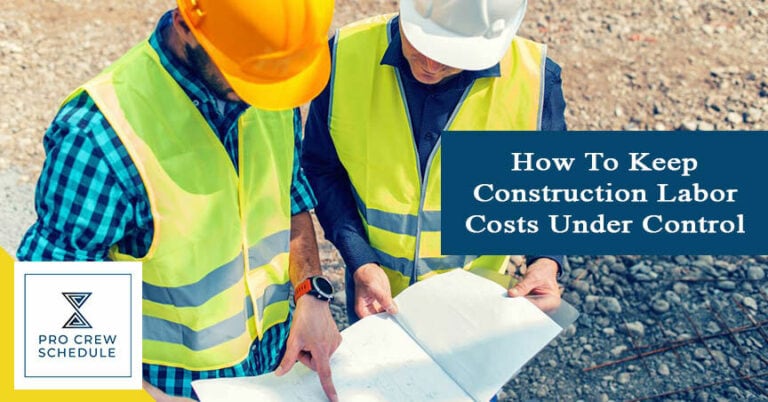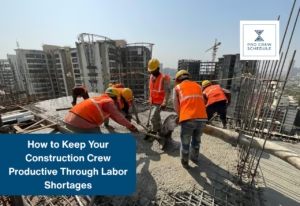Your construction crew members are one of your most important resources when managing construction. But labor costs make up a big chunk of a construction project’s budget, and if these costs go up too much, it can quickly ruin the project’s profitability and finances. Spending too much on labor can make it hard for your business to succeed in this competitive market.
Construction companies have had to deal with several problems over the past few years, such as supply chain problems, rising energy costs, and shortages of construction materials and workers. As a result, controlling labor costs is a key part of managing building costs. Contractors and project managers can ensure they stay on budget and avoid costly delays by keeping track of these costs.
Suppose you want to cut down on some of your labor-related costs and keep them in check. In that case, this article will show simple strategies you can implement to keep your profitability and standards high without lowering salaries or firing people.
What Are Labor-related Costs in Construction?
The cost of construction labor is the amount paid to the people working on the building. This includes people who work as builders, project managers, and office workers. Construction labor costs depend on where the site is, what kind of job it is, and how skilled the workers must be.
In this section, let us look at the labor-related costs in construction.
Direct Work Costs
These costs are directly linked to making goods and services. These are the wages and bonuses paid to workers involved in building. Carpenters, electricians, plumbers, supervisors, and other construction crew members are examples of direct work costs.
Indirect Work Costs
On the other hand, indirect work costs are related to workers who are not directly involved in making things but who help with the building job in other ways. These people could be your administrative team, project managers, office workers such as finance or accounting, and safety officials.
Since indirect labor costs are spread across different areas, keeping track of them can take more work. Keeping accurate records of these costs is critical to keep them in check.
Overtime Costs
Overtime costs are the extra pay employees get when they work past their normal hours or outside their normal work routine. In building, these costs can add up to a lot, especially if the project deadline is tight or if there are delays that were not expected. While putting in extra hours is critical to hitting milestones, keeping track of your crew’s work hours and not overworking them is important. A construction crew management system can help you schedule your activities and tasks more efficiently.
Training Costs
These are the costs of giving employees chances for skill development and knowledge. Training costs include safety training, equipment use, project management, and other specific skills. Training can be expensive, but it is an investment that pays off for building companies. It can also increase engagement and retention, as employees feel their employers are taking time and money to boost their careers.
Travel Costs
Travel costs are the costs that come up when an employee needs to travel. These costs include flights, hotels, meals, and car rentals. If you are handling multiple projects simultaneously, some workers may need to visit a different city’s job site. Construction crew dispatch software is one way to manage team members’ activities and schedules across different sites and avoid miscommunication and mismanagement.
Subcontractor Fees
These are the costs of hiring outside contractors to do certain project parts. Subcontractors often do specialized work like concreting, plumbing, electrical, wiring, installing HVAC systems, and other skills. When hiring a subcontractor, construction companies will set up a bidding process to get bids from several subcontractors and pick the most competitive one.
Union prices
These are the costs that come with hiring workers who are in a union. Labor unions discuss collective bargaining agreements on behalf of their members, and employers may have to pay for things like union dues and contributions to benefits.

Why it is Critical To Keep Construction Labor Costs in Check
Controlling building labor costs well can help your business in many ways, like making sure projects are done on time and budget and that resources are used well. Efficient and effective cost management helps you determine what risks and problems might arise from workers and how to deal with them. In this section, we listed some of the benefits of keeping track of labor-related costs.
Stay Within Budget
Effective labor cost management helps control costs and ensures the project stays on budget. If the cost of labor for a certain job goes over what was planned, it can affect the budget and leave less money for labor on other tasks. Keeping an eye on work costs can help you save money, lower overhead costs, and make more money in the long run.
Keep Within Timelines and Schedules
Estimating labor costs correctly and keeping track of everything can help ensure the job is finished on time. If labor prices are not managed well, there may not be enough workers or workers with the right skills. That, in turn, can lead to mistakes and wait times, significantly affecting your timelines and completion dates.
Distribute Materials and Resources Well
Focusing on labor cost management helps ensure workers are used in the best way possible. If the labor cost exceeds expected, it can change how other resources, like materials and tools, are used. It takes longer to finish certain tasks if you do not have the right resources when you need them.
Boost Profitability
By keeping track of labor costs well, building project managers can determine how to make the job site more productive and efficient. If workers are well-compensated for the job and have a good working environment, it can help motivate them and take ownership of the tasks. If labor costs are handled well, workers can be scheduled in a way that makes the most use of their time.
Follow the Rules and Regulations
Controlling labor costs means following labor laws and rules, like those about minimum wage and extra pay. If a company fails to follow them, it could face legal and financial penalties and hurt its image.
Strategies On How to Keep Construction Labor Costs Down
Calculating labor costs can be hard and take a lot of time, especially when there are many different kinds of work on a big job. Here are some tips to help you control your labor prices.
Focus on Effective Planning and Scheduling
Planning and scheduling your activities and tasks are crucial to keep labor costs down and finish jobs on time. To keep these costs in check, you can divide the schedule into smaller jobs, giving each one a clear goal and a set amount of time. This can help determine which jobs are essential to the project’s success and which can be cut to save money. With a clear plan, everyone knows when they will get paid. This is also a good way to find and eliminate unnecessary overtime and conflict.
Invest in Technology
Construction scheduling software is one of the many tools to help you make your project management more efficient. The cloud-based technology allows all stakeholders access to the same updated information on the project’s progress. Workers can also keep track of their schedules and see their tasks for a specific period. These tools on the site can also automate tasks and cut down on costly mistakes people make.
Monitor Labor Costs
Set a baseline amount for labor costs at the start of a project to keep track of labor costs. The baseline will be used to track how much the job costs as it goes along. When you know the actual costs and have a budget, you will be able to spot cost overruns and ways to save money, and you will be able to fix problems quickly.
Keep Track Of Your Project’s Progress and Performance
If you keep track of your project’s progress and performance against your plan regularly, you’ll be able to spot possible delays or cost overruns early on. This will let you fix the problem before it is too late. And if you have this information, you can use it to make good changes for the future.
Hire the Right People For The Job
Hiring the right people can make a big difference, especially in today’s market, where labor shortages and prices increase. With a good hiring process, you can find people with the skills and experience you need and lower the chance of making mistakes that take more time to fix.
Cross-train Your Construction Crew
If you keep looking and observing how they work, you will find that some of your team members are more adaptable. It would be smart to teach these workers how to do various tasks on the spot.
This way, you can replace a different worker with someone who can do more than one job, saving money on unneeded labor costs. But it would help if you talked to the managers on-site before making a choice.
Review and Evaluate Costing Reports
Project and job costing reports to determine where your business might be spending too much. During a project, you can check if you are still on track by comparing your job cost reports to your prices. You can look at the changes between your job cost reports and your quotes after a project is done to make your future quotes more accurate.






